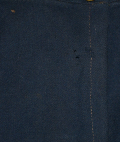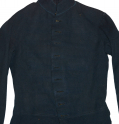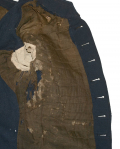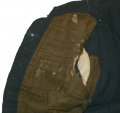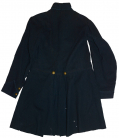site search
online catalog
CIVIL WAR ENLISTED INFANTRYMAN’S FROCK COAT: ISSUED, WORN IN FIELD, BROUGHT HOME BY THE VETERAN, PRESERVED BY THE FAMILY
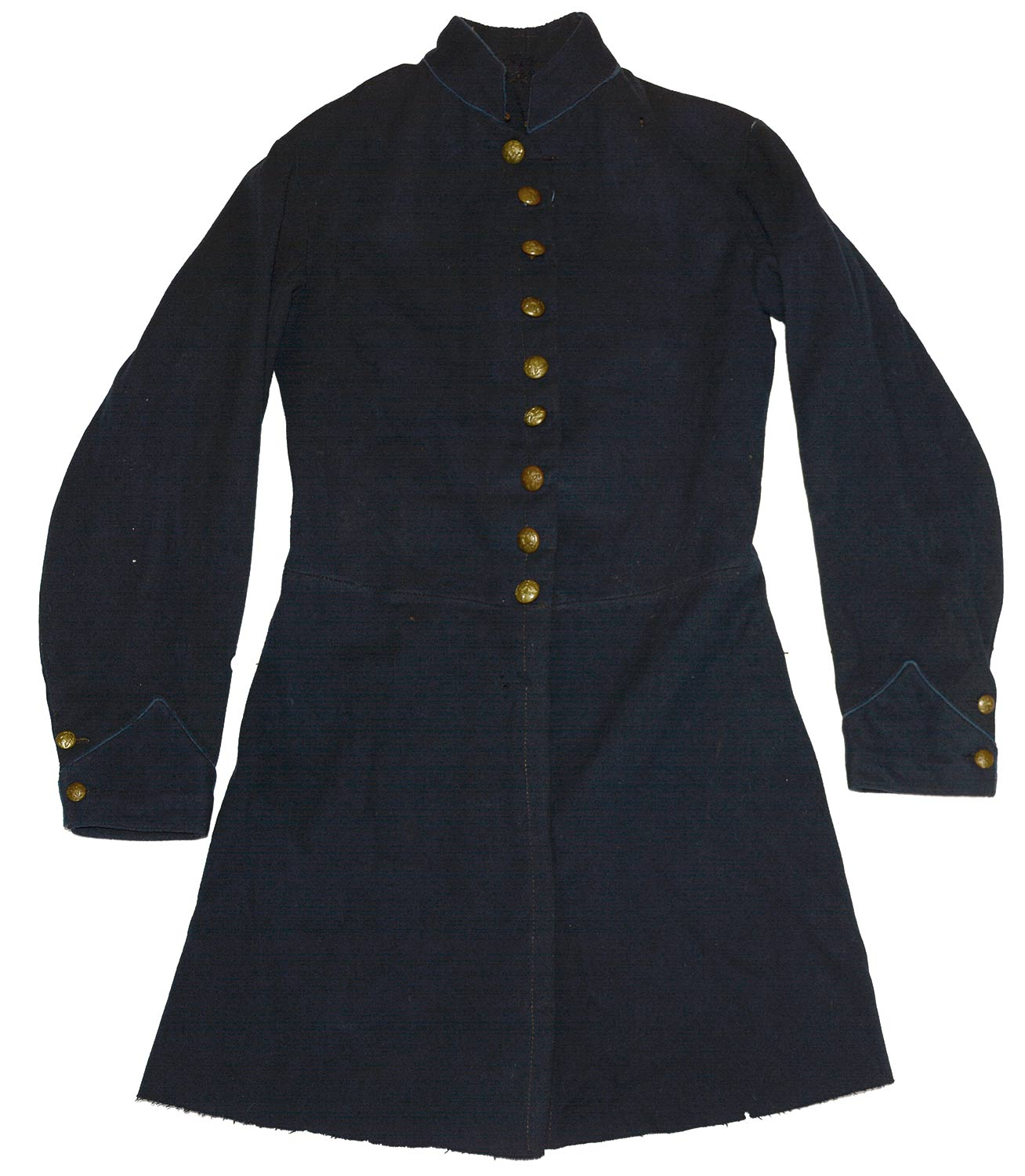
$6,950.00 SOLD
Quantity Available: None
Item Code: 545-35
This Civil War U.S. infantry enlisted man’s frock coat is fully regulation issue with a nine-button front, two-button cuffs, and two buttons on the rear waist. The standing collar and functional cuffs are piped in light blue, the branch of service color for infantry. This pattern was adopted in 1858 as a slight modification of the 1854 and 1855 patterns, using the same collar and cuff design, but returning to a non-pleated waist. These coats were intended to be worn as dress coats in conjunction with the broad-brimmed 1858 army hat, a.k.a. the Jeff Davis or Hardee hat, but were also worn in the field, usually with the standard issue fatigue cap, as many period photos show. (We show the famous A.J. Russell photo of troops of Brooks’s 6th Corps Division at Fredericksburg in May 1863 to illustrate the point.)
This is a great example of a very good condition field-worn coat showing just the slightest bit of fading from exposure, and some wear in expected places in the lining, what is likely a soldier’s repair to shoulder seam, and a few moth nips from storage, things that are valued and appreciated in coat that was actually issued, worn by a soldier, brought home from the war, and preserved by his family. In addition to showing some legitimate age and field use, the coat also shows the manufacturer/contractor’s ink stamp inside one shoulder, rubbed on the lower line from wear, but the top line clearly reading “JAMES B. BOYLAN,” a New Jersey clothier who operated with his brother John, and had US government contracts for tens of thousands of Federal uniforms during the war, ranging from infantry great coats, sack coats, VRC jackets, cavalry trousers, cavalry jackets, etc., to 75,000 infantry coats between February and June 1864 (Bazelon, Vol. 1, p.31.)
The body is dark blue wool, lined and slightly padded in the chest and sides, and, correctly, not in the back or skirts, with white muslin sleeve linings and polished cotton pockets in the tails that are accessible from the outside. The skirts are full length and unhemmed, as is correct. The buttons are the correct general service eagle buttons- nine large on the front, two large on the rear waist, and two small on each functional cuff. Those on the front show old restitching, which would be natural for a coat actually worn. The second from the top was redone by a collector with no attempt to hide the fact by using light blue thread. The hook and eye are in place at the base of the collar. The coat also preserves the small hooks and eyes near the lower edge of the skirt front and tails that were to enable the soldier to turn back and fasten the skirts, though it would have given the coat a rather colonial appearance and we can’t recall any image of a Civil War soldier doing so. The hook and eye are both in place on the wearer’s right. The small eye is missing from the rear of the skirt on the left.
The front of the coat shows very minor mothing: a couple small nips on the right sleeve, the left shoulder and one on left breast, and two or three pencil point holes on the skirt just below the waist. The back shows two moth nips on the collar that shows the buckram interlining. There are half a dozen less noticeable small holes on the right shoulder blade, and four or five on the lower left. The left shoulder seam shows some old restitching that appears to be a wartime soldier’s repair. There are two or three other moth nips just above the waist on the lower left, and we just one on the vent piece of right skirt. None of these needs repair or backing. They are not very noticeable and the coat as a whole is very stable. The seam of the left vent piece and left skirt, however, has come unstitched about half-way down the pocket. No fabric is missing and this should be an easy, invisible repair. It does not show, of course, but structurally it should be done. The pocket itself is present, as is the reinforcing strip at its opening, and is complete, but its seam is likewise open.
The interior is complete with the sleeves lined in white muslin and the body, correctly, lined and padded in the chest and sides and not in the back or in the skirts. The inside of the collar shows an old repair and lower center, and some wear to the lining along the collar bone, as should be expected. The other spots of wear to the lining, some exposing the padding are at natural points of contact and rubbing: the shoulder, armpit and sides, and should be left as is. There is no breast pocket. The tail pockets are complete and in good condition, showing some nice staining from having been used, though as mentioned above the left tail pocket likely should be restitched at some point.
This is a really interesting coat that both displays very well, was made by a well known contractor, and reveals some interesting history on close inspection. The soldier’s name, unfortunately, has been lost, but the coat was obviously meaningful enough to him and his family to preserve. [sr] [ph:L]
~~~~~~~~~~~~~~~~~~~~~~~~~~~~~~~~~~~
THIS ITEM, AS WITH ALL OTHER ITEMS AVAILABLE ON OUR WEB SITE,
MAY BE PURCHASED THROUGH OUR LAYAWAY PROGRAM.
CLICK HERE FOR OUR POLICIES AND TERMS.
THANK YOU!
Inquire About CIVIL WAR ENLISTED INFANTRYMAN’S FROCK COAT: ISSUED, WORN IN FIELD, BROUGHT HOME BY THE VETERAN, PRESERVED BY THE FAMILY
For inquiries, please email us at [email protected]
Most Popular
Historical Firearms Stolen From The National Civil War Museum In Harrisburg, Pa »
Theft From Gravesite Of Gen. John Reynolds »
Selection Of Unframed Prints By Don Troiani »
Fine Condition Brass Infantry Bugle Insignia »
British Imported, Confederate Used Bayonet »
Scarce New Model 1865 Sharps Still In Percussion Near Factory New »
featured item
WONDERFUL CONDITION ORIGINAL CONFEDERATE-MANUFACTURED KEPI FOR A DRUMMER BOY OR CHILD
This article of uniform clothing is an original, Civil War example of headgear manufactured in the Confederacy and presented here in wonderful, original intact condition. The period artifact is a small, dark blue colored, wool kepi, suited for a… (526-68). Learn More »
site search
Upcoming Events
May 16 - 18: N-SSA Spring Nationals, Fort Shenandoah, Winchester, VA Learn More »







